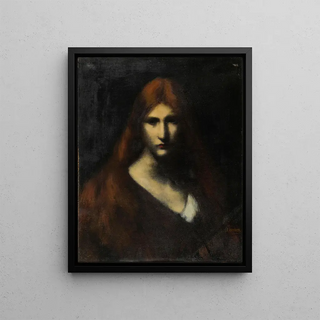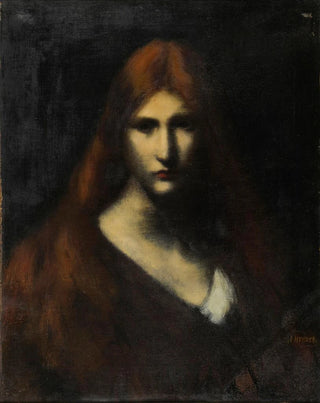Art print | Fabiola - Jean-Jacques Henner Source: Reproduction | Fabiola - Jean-Jacques Henner


View from behind

Frame (optional)
Fabiola - Jean-Jacques Henner – Captivating Introduction
The artwork "Fabiola" by Jean-Jacques Henner is a masterpiece that embodies the very essence of beauty and spirituality. Painted at the end of the 19th century, this piece depicts Fabiola, an iconic figure of Christianity, known for her piety and compassion. Henner, through his art, manages to capture not only the physical appearance of his model but also the soul and emotion surrounding her. The soft light enveloping Fabiola's face, along with the depth of colors, invites the viewer to an introspective contemplation, thus revealing the depth of faith and devotion. The art print of this piece allows you to immerse yourself in a universe where art and spirituality meet, offering a visual experience that transcends time.
Style and uniqueness of the artwork
Jean-Jacques Henner's style is characterized by a masterful use of color and light, elements that make "Fabiola" a unique art print. Influenced by the Romantic movement, Henner favors warm tones and subtle contrasts to bring his subjects to life. In "Fabiola," the richness of the drapery, the delicacy of the features, and the softness of the gaze create an intimate and emotional atmosphere. The artist plays with shadows and lights to accentuate the spirituality of his model, making the scene almost palpable. This distinctive approach, blending realism and idealization, gives the art print a timeless dimension, where each glance at the artwork reveals new nuances and interpretations.
The artist and his influence
Jean-Jacques Henner, born in 1829 in Strasbourg, is one of the most representative artists of the French academic movement. His career is marked by a constant quest for harmony between form and color. Henner succeeded in establishing himself in the art world thanks to his refined technique and his ability to evoke deep emotions through his portraits and religious scenes. His encounters with masters such as Delacroix and Ingres enriched his artistic approach, allowing him to explore a variety of themes, ranging from

Matte finish

View from behind

Frame (optional)
Fabiola - Jean-Jacques Henner – Captivating Introduction
The artwork "Fabiola" by Jean-Jacques Henner is a masterpiece that embodies the very essence of beauty and spirituality. Painted at the end of the 19th century, this piece depicts Fabiola, an iconic figure of Christianity, known for her piety and compassion. Henner, through his art, manages to capture not only the physical appearance of his model but also the soul and emotion surrounding her. The soft light enveloping Fabiola's face, along with the depth of colors, invites the viewer to an introspective contemplation, thus revealing the depth of faith and devotion. The art print of this piece allows you to immerse yourself in a universe where art and spirituality meet, offering a visual experience that transcends time.
Style and uniqueness of the artwork
Jean-Jacques Henner's style is characterized by a masterful use of color and light, elements that make "Fabiola" a unique art print. Influenced by the Romantic movement, Henner favors warm tones and subtle contrasts to bring his subjects to life. In "Fabiola," the richness of the drapery, the delicacy of the features, and the softness of the gaze create an intimate and emotional atmosphere. The artist plays with shadows and lights to accentuate the spirituality of his model, making the scene almost palpable. This distinctive approach, blending realism and idealization, gives the art print a timeless dimension, where each glance at the artwork reveals new nuances and interpretations.
The artist and his influence
Jean-Jacques Henner, born in 1829 in Strasbourg, is one of the most representative artists of the French academic movement. His career is marked by a constant quest for harmony between form and color. Henner succeeded in establishing himself in the art world thanks to his refined technique and his ability to evoke deep emotions through his portraits and religious scenes. His encounters with masters such as Delacroix and Ingres enriched his artistic approach, allowing him to explore a variety of themes, ranging from






